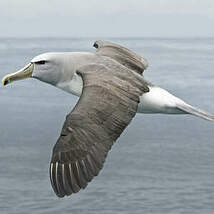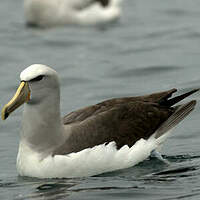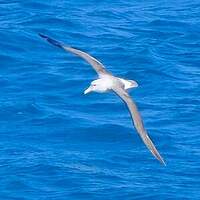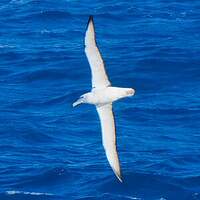Salvin's Albatross
Thalassarche salvini - Albatros de Salvin
Identification
Sometimes still considered as a subspecies of the White-capped Albatross (Thalassarche cauta), the Salvin's Albatross is a species of medium-sized albatross, much smaller than the Wandering and the Royal Albatross. This bird is distinctive with its dark-colored upper wings and mantle, and white underside except for the black leading and trailing edges, as well as for the wingtip and rectrices. The head is grey with a darker mark in front of the eye. The beak is grey with a black spot at the end, especially on the lower mandible. Its head and beak features severely differentiate it from other grey-headed Albatross. The younger birds look quite similar to the adults. In younger flying birds, it is sometimes hard to differentiate this species from the Chatham Albatross (T. eremita).
Subspecific information monotypic species
Foreign names
- Albatros de Salvin,
- Albatros de Salvin,
- albatroz-de-dorso-cinzento,
- Salvinalbatros,
- szürkehátú albatrosz,
- Salvins Albatros,
- Albatros di Salvin,
- salvinalbatross,
- Sølvhodealbatross,
- albatros kapucňový,
- albatros snarský,
- Grårygget Albatros,
- Salvinalbatros,
- albatros de Salvin,
- albatros szarogrzbiety,
- Альбатрос Сальвина,
- サルビンアホウドリ,
- 萨氏信天翁,
- salvinalbatross,
- 沙文氏信天翁,
Habitat
Behaviour character trait
Flight
Dietfeeding habits
Reproduction nesting
Geographic range
Endemic to New Zealand, Salvin's Albatross nests on a few archipelagos (the Bounty Islands, which host 99% of the total population, The Snares and Chatham Islands), and also previously nested in Crozet (France). It winters in large numbers between New Zealand and Chile, mostly in the Humbolt current, between latitude 14 to 50 degrees South. It is much less common out in the coastal waters off of South Africa and Australia.
Threats - protection
IUCN conservation status
concern
in the Wild
threatened
evaluated
Not threatened on its predation-free breeding sites but may suffer from adverse weather conditions. It is one of the most frequently killed albatrosses by high seas fishing practices, both by trawlers and those that use lines of several kilometers. This species accounts for 15% of the albatrosses killed by New Zealand fishers. The population was estimated to be approximately 31 000 couples in 1998.
Sources of information
- IOC World Bird List (v15.1), Gill, F and D Donsker (Eds). 2025-12-07.
- Albatrosses, Petrels and Shearwaters of the World, Onley Derek et Scofield Paul
- Field Guide to New Zealand Seabirds, Parkinson Brian
- Seabirds, an identification guide, Harrison Peter
- The hand guide to the birds of New Zealand, Robertson Hugh et Heather Barrie
- Avibase, Lepage Denis
- BirdLife International, BirdLife International
- Vol. 1 - Handbook of the Birds of the World, Josep del Hoyo-Andrew Elliot-Jordi Sargatal
Other sources of interest
 Specification sheet created on
01/08/2023 by Georges Olioso
Specification sheet created on
01/08/2023 by Georges OliosoTranslation by AI Oiseaux.net
© 1996-2026 Oiseaux.net
- Accipitriformes
- Aegotheliformes
- Anseriformes
- Apodiformes
- Apterygiformes
- Bucerotiformes
- Caprimulgiformes
- Cariamiformes
- Casuariiformes
- Charadriiformes
- Ciconiiformes
- Coliiformes
- Columbiformes
- Coraciiformes
- Cuculiformes
- Eurypygiformes
- Falconiformes
- Galliformes
- Gaviiformes
- Gruiformes
- Leptosomiformes
- Mesitornithiformes
- Musophagiformes
- Nyctibiiformes
- Opisthocomiformes
- Otidiformes
- Passeriformes
- Pelecaniformes
- Phaethontiformes
- Phoenicopteriformes
- Piciformes
- Podargiformes
- Podicipediformes
- Procellariiformes
- Psittaciformes
- Pterocliformes
- Rheiformes
- Sphenisciformes
- Steatornithiformes
- Strigiformes
- Struthioniformes
- Suliformes
- Tinamiformes
- Trogoniformes



























